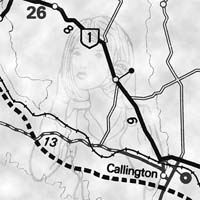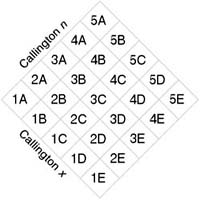For only about the second time in five years, I’m writing something out in conventional music notation for a real, live musicians. I’m trying to use a music notation program but I’m finding it a particularly frustrating experience. First of all, there’s the learning curve you get with every new piece of software, but that’s to be expected.
What’s really vexed me is how the software brings the contradiction, between what makes sense to humans and what makes sense to computers, to a crisis. I just want to write down a fairly simple succession of sounds, without any particular constant beat. It’s simple to enter this into a MIDI sequencer and have the computer play it back without a hitch, but if I convert it straight to sheet music it will look like a jumbled mess.
On the other hand, it would be simple for me to write the music out by hand, and the musician could immediately understand what was going on, but the software can’t intuitively grasp concepts and becomes hopelessly confused. It needs a regular, steady beat, and needs to know how many beats will be in each bar before it begins to fill them with notes and silences.
This is like trying to draw parabolae with an Etch-a-Sketch.
Filed under: Music by Ben.H
No Comments »
Azerbaijan unclear on concepts of Eurovision, Europe
Tuesday 18 August 2009
Pace Terry Wogan, Eurovision is not always a vote-for-your-neighbour contest. A total of just 43 people in Eurovision newcomer Azerbaijan voted for neighbouring country and traditional rival Armenia. How do we know? Because officials from the Azerbaijani National Security Ministry are rounding them up:
“They wanted an explanation for why I voted for Armenia. They said it was a matter of national security,” Nasirli said. “They were trying to put psychological pressure on me, saying things like, ‘You have no sense of ethnic pride. How come you voted for Armenia?’ They made me write out an explanation, and then they let me go.”
Disappointing news. It makes one yearn for the simpler, more innocent days of yore, when Eurovision points were allocated on the decisions of government-appointed judges, without all this pesky voting messing things up.
Filed under: Music, Stupidity, Television by Ben.H
No Comments »
Great Performances
Saturday 15 August 2009
Good news, everyone! I’ve fixed the dodgy music files in The Listening Room. It turns out that some of the pieces had been enocoded as mp3s at 48kHz instead of 44.1kHz, leading to Van Halen-like shenanigans. Everything should sound crystal-clear now.
Also, you may have noticed the little blue ‘listen’ buttons popping up on the blog. I’ve started using that Delicio.us play tagger thing which lets you listen to any mp3 on the site at the click of a mouse (or two clicks, if you have a Flash blocker installed). These have also been included on the music pages, so you can hear anything you want at the merest whim.
Filed under: Music, Self-promotion by Ben.H
No Comments »
Please Mister Please
Saturday 15 August 2009
(6’13”, 8.53 MB, mp3)
Filed under: Please Mister Please by Ben.H
No Comments »
Get Off My Lawn!
Thursday 13 August 2009

Filed under: The Bunker by Ben.H
4 Comments »
Filler By Proxy LXXIII: Round The Worst In A Tall Canoe
Monday 10 August 2009
Filed under: Art, Filler By Proxy, Stupidity by Ben.H
No Comments »
This is the New Music! Callington
Saturday 8 August 2009
New mp3s ready for download or streaming.
This way of working was a conscious attempt at “formalizing” a disorientation of memory… In this regularity, there is a suggestion that what we hear is functional and directional, but we soon realize that this is an illusion; a bit like walking the streets of Berlin — where all the buildings look alike, even if they’re not.
— Morton Feldman, “Crippled Symmetry”
 The set of pieces that make up Callington began with the vision of an image I couldn’t make real. For some years now I’ve been interested in using means of visual processing to make music, with limited success. In this case, I’d been imagining the music of a spectrogram, itself made up of a montage of spectrograms of different musics, laid over each other with continuously varying degrees of transparency.
The set of pieces that make up Callington began with the vision of an image I couldn’t make real. For some years now I’ve been interested in using means of visual processing to make music, with limited success. In this case, I’d been imagining the music of a spectrogram, itself made up of a montage of spectrograms of different musics, laid over each other with continuously varying degrees of transparency.
Not too surprisingly, my attempts to make music from such an image have so far all been unsuccessful. The few image-to-sound converters I have worked with interpret spectrographic information (intensity of frequency over time) in ways that make an actual spectrogram sound clumsy and dull. As an alternative, I patched together a system of filters and mixers to simulate the sort of effect I imagined the spectrograms would create.
The entirety of Callington is based upon five source sounds, each of a similar nature and roughly similar length. Only four of these source elements are used in any one piece. For each subsequent piece (Callington 2A, Callington 3A, etc) one of the sources is substituted, until all five possible combinations of four sources are used. Each piece is thus designed to differ as little as possible from its neighbours.
Each subsequent iteration of the source material (Callington 1B, Callington 1C, etc) is an imitation of its predecessor, using a different technological approach to mimic the previous section as best it can (full details here). Each section is thus a failed attempt to maintain a uniform identity throughout the entire piece.
The many small differences can be said to be caused by ‘mishearings’ as the music is translated from one format to another. This consistency is carried over into all the pieces, each sharing three of its four source materials with the others. The main noticeable difference between sections is in timbre. The outer sections have complex timbres and dynamics, whereas the inner sections reduce this material to a uniform timbral simplicity.
 The twenty-five sections can be played individually or juxtaposed in a variety of ways. In particular, two ways present themselves as obvious arrangements. In Callington x, each successive iteration of the same source material is played (e.g. Callington 1A, 1B, 1C, 1D, 1E). The other, Callington n, groups common treatments of the different sets of material (e.g. Callington 1A, 2A, 3A, 4A, 5A). Other permutations, of course, are possible.
The twenty-five sections can be played individually or juxtaposed in a variety of ways. In particular, two ways present themselves as obvious arrangements. In Callington x, each successive iteration of the same source material is played (e.g. Callington 1A, 1B, 1C, 1D, 1E). The other, Callington n, groups common treatments of the different sets of material (e.g. Callington 1A, 2A, 3A, 4A, 5A). Other permutations, of course, are possible.
The multi-movement versions can be played from these m3u playlists:
Callington 1 Callington A
Callington 2 Callington B
Callington 3 Callington C
Callington 4 Callington D
Callington 5 Callington E
The entire set, along with detailed composition notes, can be downloaded from its page on the music website, or heard in streaming audio at The Listening Room.
Filed under: Music by Ben.H
No Comments »
Please Mister Please
Thursday 6 August 2009
(3’25”, 4.38 MB, mp3)
Filed under: Please Mister Please by Ben.H
No Comments »
No wonder London’s public transport is so unreliable.
Thursday 6 August 2009
Filed under: London, Stupidity by Ben.H
No Comments »
Filler By Proxy LXXII: You Passed Too Bad Gas!
Monday 3 August 2009
Hooray! StSanders, the genius who gave the world so many excellent shreds of the world’s finest guitar heroes, has raised the stakes in a new video that’s gonna make the people sway and rock and clap their hands to the beat. Hooray!
Because YouTube kept taking them down, the complete gallery of shreds can now be found here.
Filed under: Filler By Proxy, Music, Stupidity by Ben.H
No Comments »
Filler By Proxy LXXI: So It’s Come To This, A Post About Cats
Sunday 2 August 2009
These videos have been doing the rounds, but I feel obliged to link to them because of my obsession with reworking Schoenberg’s Opus 11. An exemplar of how the internet wastes your time, Cory Arcangel has produced a performance of Schoenberg’s Three Piano Pieces on his website. The angle? It’s made up entirely of snippets of YouTube videos of cats on piano keyboards.
It’s not quite an infinite number of monkeys, but…
first I downloaded every video of a cat playing piano I could find on Youtube. I ended up with about 170 videos. Then I extracted the audio from each, pasted these files end to end, and then pasted this huge file onto the end of an audio file of Glenn Gould playing op11. I loaded this file into Comparisonics. Comparisonics, a strange free program I found while surfing one night…
Full details, and the videos, on his website.
Filed under: Filler By Proxy, Music by Ben.H
No Comments »
The Composer and His Audience
Friday 31 July 2009
Visitors Unwelcome.
Roman Catholic Nuns in Full Habit May Enter Without An Appointment.
Occupant is a Heathen Chinee. Missionaries at this door will face the Dowager Empress and another Boxer Rebellion. Please do not disturb 11.00 am to 2.00 pm. Missionaries – never.
Filed under: Music by Ben.H
No Comments »
Please Mister Please
Wednesday 29 July 2009
(6’29”, 5.55 MB, mp3)
Filed under: Please Mister Please by Ben.H
No Comments »
I Am Cleaning Up Some Scans Of Old Slides
Wednesday 29 July 2009
He’s got a million of them
Tuesday 28 July 2009
Among the memorials and tributes to Merce Cunningham, I’ve seen yet another pithy quote from Morton Feldman which I didn’t know about before. I don’t know where this one comes from, but it’s in a description of the unusual way Cunningham often worked with artists and composers he knew well.
His works may have a score, but it’s made separately from the choreography; the same can go for the set. Elements meant to work together in performance are created independently by a cohort of trusted collaborators. Composer Morton Feldman explained the process like this: “Suppose your daughter is getting married and her wedding dress won’t be ready until the morning of the wedding, but it’s by Dior.”








